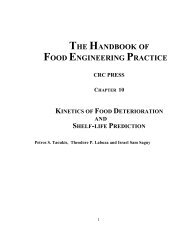A combined discreteâcontinuous model describing the lag phase of ...
A combined discreteâcontinuous model describing the lag phase of ...
A combined discreteâcontinuous model describing the lag phase of ...
You also want an ePaper? Increase the reach of your titles
YUMPU automatically turns print PDFs into web optimized ePapers that Google loves.
R.C. McKellar, K. Knight / International Journal <strong>of</strong> Food Microbiology 54 (2000) 171 –180 173<br />
estimate individual cell <strong>lag</strong> times (Pin and Baranyi, t (h), that is, <strong>the</strong> time required for <strong>the</strong> Bioscreen to<br />
d<br />
1998). Given <strong>the</strong> limitations and inherent inac- record a 0.05 increase in optical density from t .<br />
0<br />
curacies <strong>of</strong> <strong>the</strong> calibration method, <strong>the</strong> td<br />
approach Duplicate wells for each dilution were used for <strong>the</strong><br />
would seem to be <strong>the</strong> only valid one.<br />
preparation <strong>of</strong> a standard curve <strong>of</strong> log OD against<br />
The purpose <strong>of</strong> <strong>the</strong> present study was to (1) obtain cfu/ml. For <strong>the</strong> determination <strong>of</strong> m, five replicate<br />
data on <strong>the</strong> <strong>lag</strong> <strong>phase</strong> experienced by single cells <strong>of</strong> wells were used for each dilution, with 20 replicate<br />
Listeria monocytogenes using <strong>the</strong> Bioscreen and (2) wells being used for dilutions which were close to 0<br />
develop a discrete–continuous <strong>model</strong> which com- cfu/ml.<br />
bines cell adaptation as a property <strong>of</strong> individual cells Viable cells were enumerated for each two-fold<br />
(discrete activity) with a continuous <strong>model</strong> for dilution by spread plating 0.1 ml <strong>of</strong> appropriate serial<br />
bacterial growth.<br />
dilutions in duplicate onto tryptic soy agar (TSA;<br />
Difco Labs.). The plates were incubated at 308C for<br />
48 h and colonies were counted using a Quebec<br />
Colony Counter (Model 15; American Optical, Buf-<br />
2. Materials and methods<br />
2.1. Strains and culture conditions<br />
Dynamic <strong>model</strong>s were created using<br />
©<br />
ModelMaker Version 3.0 (Cherwell Scientific Pub-<br />
lishing, Oxford, UK).<br />
The Gompertz and heterogeneous population<br />
(HPM) (McKellar, 1997) <strong>model</strong>s were fit to growth<br />
data (obtained ei<strong>the</strong>r from actual or simulated cell<br />
®<br />
counts) using Scientist (Micromath Scientific S<strong>of</strong>t-<br />
ware, Salt Lake City, UT, USA). A modified Powell<br />
algorithm was used to minimize <strong>the</strong> sum <strong>of</strong> squared<br />
deviation between observed data and <strong>model</strong> calcula-<br />
tions. Initial parameter estimates were obtained using<br />
simplex optimization. Differential equations were<br />
solved numerically by <strong>the</strong> method <strong>of</strong> Runge–Kutta,<br />
since <strong>the</strong> s<strong>of</strong>tware does not require analytical forms<br />
<strong>of</strong> equations.<br />
Prism Version 2.0 (GraphPad S<strong>of</strong>tware for Intuitive<br />
Science, San Diego, CA, USA) was used to<br />
create plots.<br />
Listeria monocytogenes Scott A (human clinical<br />
isolate) was obtained from <strong>the</strong> culture collection at<br />
<strong>the</strong> Food Research Program (Guelph, Canada). The<br />
culture was grown for 24 h at 308C in tryptic soy<br />
broth (TSB; Difco Labs., Detroit, MI, USA). Stock<br />
cultures were prepared in TSB plus 15% glycerol<br />
(BDH, Toronto, Canada) and were frozen in 0.3-ml<br />
aliquots in cyrovials at 2 258C.<br />
The contents <strong>of</strong> one cyrovial was transferred to 10<br />
ml <strong>of</strong> TSB, incubated for 24 h at 308C in a shaking<br />
waterbath (New Brunswick Scientific, Edison, NJ,<br />
USA) at 1500 rpm. The culture was transferred (1%)<br />
to 10 ml fresh TSB and incubated under <strong>the</strong> same<br />
conditions. The resulting culture was used as <strong>the</strong><br />
inoculum for experiments. API Listeria spp. Identifi-<br />
cation Strip (BioMerieux Canada, St. Laurent,<br />
Canada) was used to confirm <strong>the</strong> identity <strong>of</strong> <strong>the</strong><br />
culture.<br />
2.2. Bioscreen growth experiments<br />
falo, NY, USA).<br />
2.3. Modeling<br />
Serial two-fold dilutions <strong>of</strong> <strong>the</strong> inoculum were 3. Results<br />
made using fresh TSB to obtain a range <strong>of</strong> dilutions<br />
5<br />
representing approximately 10 to 0 cfu/ml. From Kinetic parameters <strong>describing</strong> bacterial growth can<br />
each <strong>of</strong> <strong>the</strong> two-fold dilutions, 0.35 ml was trans- be determined from turbidity data (Cuppers and<br />
ferred to wells <strong>of</strong> a Bioscreen plate (Labsystems, Smelt, 1993). Plots <strong>of</strong> td<br />
obtained from serial dilu-<br />
Helsinki, Finland). The filled plates were placed in tions <strong>of</strong> <strong>the</strong> original inoculum against ln cfu/ml (Fig.<br />
<strong>the</strong> Bioscreen (Labsystems) at an incubation temslope<br />
1) gave straight lines, and m was calculated from <strong>the</strong><br />
perature <strong>of</strong> 308C. Measurements were taken using a<br />
by Eq. (1):<br />
wide band filter, with pre-shaking at medium intensity<br />
for 10 s prior to OD reading; measurements were<br />
1<br />
m 52 ]]<br />
taken every 4 min for 25 h. Results were reported as<br />
Slope<br />
(1)














